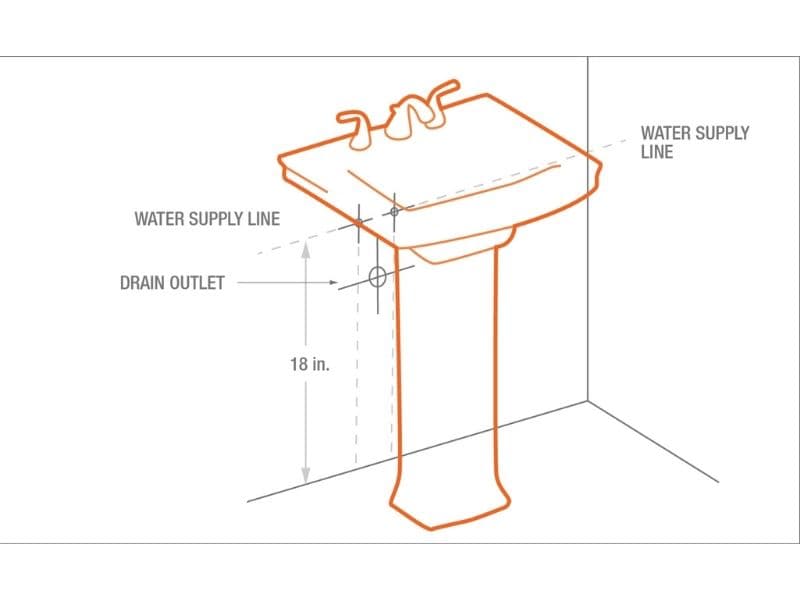Bathroom sinks are crucial since they are needed for many functions in the restroom. The people that live there have an impact on the bathroom sink’s height.
The sink drain height from the floor is 24 to 28 inches. Aside from that, rough-in plumbing maintains a height of 18 to 20 inches. When choosing the rough-in height for your sink drain, consider the P-trap location, sink drain height, connecting pipe, and the height of the counter or nearby fixtures.
Better locations are now available for the necessary connections and P-Trap. In addition, more details regarding bathroom sink plumbing rough-in heights will be provided on this page, and you will learn about the average height for bathroom sink plumbing.

What is the sink drain height from the floor?
The standard rough-in height for sink drains is 18 and 20 inches off the ground. Your P-trap will have sufficient room to drain appropriately at this distance. Additionally, it provides space for the hot and cold water lines to be installed properly.
Leave around 20 inches of room below your drain when measuring it for your sink. If not, your P-trap will be fastened to the ground. The P-trap will be closer to the floor if the sink drain is placed closer to the ground.
But don’t worry; you can modify a sink drain’s height and depth during installation or when you’re changing to another type of sink. Copper sinks are rising in popularity and should be considered for remodeling. Contrary to some misconceptions, copper sinks aren’t hard to maintain.
What is the rough-in height for a sink drain?
Kitchen sink drain rough-in heights range from 20 to 24 inches. The counter height, sink depth, and trap will affect how high the kitchen sink drain should be.
To guarantee adequate drainage, you must provide the P-trap some room. If not, the P-trap will end up hooked to the counter’s bottom. This will make it challenging to replace or repair when necessary.
As a result, you should decide on the kitchen counter’s height first. Then decide on the kitchen sink’s kind and depth. For instance, if you choose a standard sink that is 7 inches deep and a counter that is 36 inches high, the drain would be 29 inches from the floor.
Factors to consider when choosing the sink drain rough-in height
Here are the factors you consider when selecting a sink drain rough in height:
1. Where is your P-trap located?
The rough height of your sink water supply is greatly influenced by the specific location of your P-trap, making it a crucial element.
Your P-trap should be placed at a maximum height of 20 inches beneath your sink, per the International Residential Code. Your rough-in sink drain needs to be installed at a height that makes it simple to attach the P-trap.
The P-trap helps keep sewer gases away from the house by storing an amount of water that acts as a trap for the gases. When it clogs up, use a plunger to unclog it. After each use, clean the plunger as you would clean a toilet plunger.
2. Sink drain size
The size of the sink drain you intend to install is a significant component in determining the rough-in height for a sink drain. Therefore, ensure the sink drain you have access to is the appropriate size for your area.
Although most sink drains provide an 8-inch depth, most people have unique and varied preferences for the type and dimensions of the sink that will be placed.
You may have more space for a wash with a larger or more dramatic sink, but keep in mind that the size of the sink will affect the height of your rough-in. Therefore, to ensure the sink drain is mounted at a reasonable level, consider the size of your sink.
3. Your counter’s height
Since most individuals match their counters with their sinks or use the sink as an extension, the height of your counter will depend on the height of your sink.
If you plan to use this technique, ensure the counter has adequate space so the sink drain can be placed successfully.
4. Connecting pipes
Another element that will influence the roughing in of your sink drain is the connection of pipes. Your rough-in should be able to stand alone and perform as intended without interfering with any nearby lines.
Some pipes, like the ones for the hot and cold water, are put in right above the rough-in for the sink drain.
Sink distance from the wall
According to local building requirements, a single freestanding sink must be at least 15 inches away from any wall when measured from the center of the sink.
However, the National Kitchen and Bath Association advises keeping it at least 20 inches from the wall. In addition, the distance between the edge of the sink and any large objects, such as cabinets, should be at least 4 inches.
The type of sink you install will determine how far you should space it from a wall or countertop. You will consider regional building codes and professional suggestions when figuring out how much space is needed between the sink, wall, or counter.
The distance behind the faucet might vary, but sinks with countertops should be fitted with a two-inch gap in front. 4 – 6 inches should be left on both sides of the sink for the countertop.
Consider all these aspects when installing tiles in the shower. Knowing when to install fixtures determines how many tiles and when the tiles will be used.
Can you adjust the sink’s rough-in height?
The sink drain’s height can be modified, especially if the drainage system is likely to be hampered by the current height. But you need to monitor the outflow and all related components precisely.
Inaccurate measurements can compromise the correction and jeopardize safety. If you need help with the steps or need the necessary expertise, you can hire a professional plumber to adjust the height to the required point.
Conclusion
Although the ideal rough-in height for sink drains varies depending on several circumstances, it typically ranges from 18 to 20 inches above the room’s floor. Before measuring, check the P-trap location, counter height, sink size, and pipe connections.
The sink can then be appropriately installed after taking precise dimensions. Always remember that hiring a professional plumber will yield superior results, particularly if you must pass inspections or obtain a permit.
